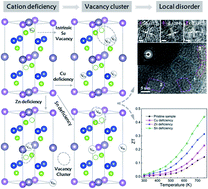Vacancy cluster-induced local disordered structure for the enhancement of thermoelectric property in Cu2ZnSnSe4†
Abstract
Low thermal conductivity is commonly seen in amorphous or disordered systems, in which electrical conductivity is also very low, bringing considerable obstacles to the development of high-performance thermoelectric materials. Present study highlights the vacancy cluster-induced local disordered structure in Cu2ZnSnSe4 for the simultaneous achievement of low thermal conductivity and high electrical conductivity, thereby significantly enhancing its thermoelectric property. Comprehensive evidences from positron annihilation and HRTEM characterizations indicated that the vacancies in cation-deficient (VCu, VZn, and VSn) samples existed as vacancy clusters containing both cation vacancies and intrinsic Se vacancies, which induced the formation of localized disorderly oriented domains. These cation deficiencies contributed to the improved electrical conductivity and power factor of the corresponding Cu2(1−x)Zn1−ySn1−zSe4 samples via an increase in the hole carrier concentration. Moreover, the induced local disordering contributed to further reduced thermal conductivity via stronger phonon scattering. As a result, enhanced ZT performance was achieved in all cation deficient samples. Among them, Sn-deficient Cu2ZnSnSe4 obtained the highest ZT value of 0.44 at 750 K, which was two times larger than that of pristine sample (ZT = 0.14 at 750 K). The cation–anion vacancy cluster and local disordered structure elucidated in the present work open up a new avenue to tackle the entanglement of thermoelectric parameters by proper vacancy modulation.



 Please wait while we load your content...
Please wait while we load your content...